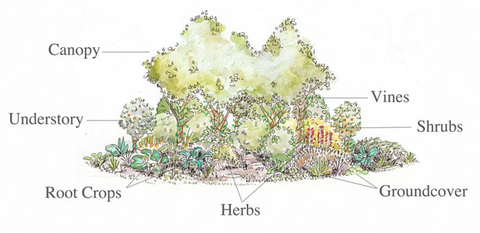Food forests - Part One
Do you want to go out into your back yard and forage for safe nutritionally dense, seasonal food from your own food forest? Not sure what a food forest is, or how to start growing one? Carry on reading and you can start to design your very own beautiful, productive, natural food forest, full of stunning, nutrient diverse, delicious food.
So what is a food forest and how is this different to an orchard?
We are all familiar with the concept of a traditional orchard. Now this could be a large commercial monocrop orchard, such as an apple orchard, or a stone fruit orchard, with long rows of fruit trees, grass on the ground. Or it could small diverse backyard orchard with all its different types of fruit trees. So we understand the concept of an orchard, so why would you want a food forest?
Well firstly let's explore what a forest is.
Wikipedia explains that although the term 'forest' is in common use, there is no universally recognised precise definition, with more than 800 definitions of forest used around the world, though it is generally agreed that a forest is usually defined by the presence of trees. Forests account for 75% of the gross primary productivity of the Earth's biosphere, and contain 80% of the Earth's plant biomass. Forest ecosystems can be found in all regions capable of sustaining tree growth, at altitudes up to the tree line, except where natural fire frequency or other disturbance is too high, or where the environment has been altered by human activity.
A forest consists of many components that can be broadly divided into two categories that are biotic (living) and abiotic (non-living) components. The living parts include trees, shrubs, vines, grasses and other herbaceous (non-woody) plants, mosses, algae, fungi, insects, mammals, birds, reptiles, amphibians, and microorganisms living on the plants and animals and in the soil.
A forest is also made up of many different layers with each layer having a different set of plants and animals depending upon the availability of sunlight, moisture and food. A natural forest is self sustaining, requiring no inputs or maintenance from us to create abundance of life.
A Food Forest, sound good, .......... so what is it again?
It's a system of gardening using a diversity range of mostly perennial, long-lived species, as opposed to annual vegetables (though I still do use some annuals in mine). These are chosen and arranged in such a way as to compliment and support each other, minimising unwanted weeds (you might still want some of the useful ones), pests and maintenance while providing a rich variety of harvests. There is no doubt that fruit trees form the centrepieces, however there is a variety of other food and support plants at different heights that are arranged in such a way that they complement each others’ needs.
Okay that all sounds great, but how do you get started? Well here are some informative videos for your to explore:
- Geoff Lawton's video explains what a food forest is https://www.youtube.com/watch?v=hCJfSYZqZ0Y, the various layers, the principles used in design and how to incorporate animals.
- Still not sure this is for you, or that it is not something that you do in an urban situation. James Prigioni video gives us 10 tips on how you can convert your lawns into food forests full of abundance https://www.youtube.com/watch?v=oLTGjiYHHbI.
- Or maybe you think it is something that can only be done where you have plenty of water for irrigation. This video link shows us how a commercial enterprise is growing a productive dryland food forest https://www.youtube.com/watch?v=MYSeE89Xv5M
- They can also look beautiful something like we would expect from a conventional garden https://www.youtube.com/watch?v=l294zaoLgoA
The 'Food Forest' website has a fact sheet to help you plan your property and you can find that here.
In Part Two I will share with what I have done on my property and why. If you are in the St George area, south west Queensland, of course you can always come and find me. Those of you who are still unsure I am happy to help.


Comments
Post a Comment